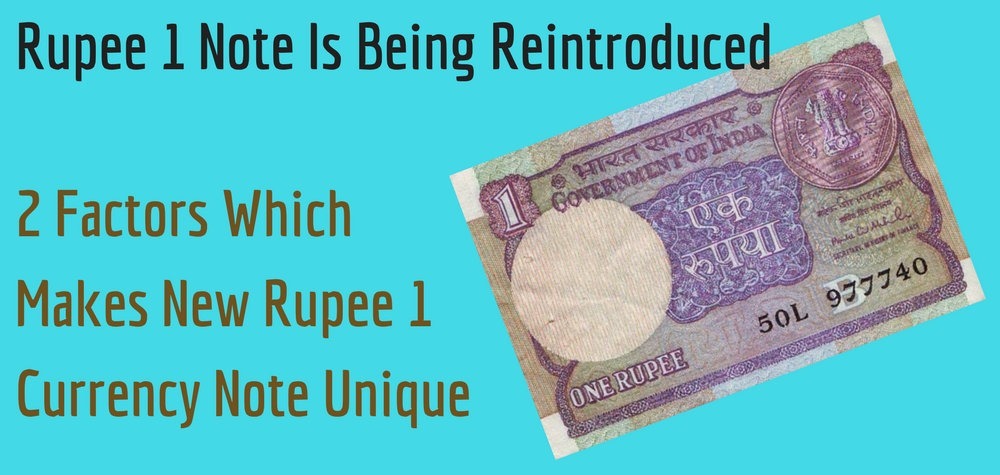2 Factors Which Makes New Rupee 1 Currency Note Unique; Reason Why They Are Being Reintroduced!

This is certainly unexpected. Govt. of India has decided to re-introduce Re 1 currency note after a gap of 22 years. The last time Re 1 note was printed, it was 1994.
The size of these new Re 1 note would be 9.7 by 8.3 cms, and the currency would be greenish-pink in colour. The last currency which was printed in 1994 was indigo in colour.
Here are two factors, which makes Re 1 currency note as unique, and completely different than any other currency note available today:
a) All other currency notes are authorised and printed by Reserve Bank of India, but Re 1 note would be authorised and legalised by Govt. of India. Hence, these notes would be ‘Bharat Sarkar’ printed on the masthead, below that, Government of India written. All other currency notes have ‘Bharatiya Reserve Bank’ & ‘Reserve Bank of India’ printed.
b) All Re 1 notes will have signatures of Rajiv Mehrishi, who is the Finance Secretary, and current Economic Affairs Secretary Shaktikanta Das, who is retiring this month itself. All other currency notes have the signature of the current RBI Governor.
After demonetization, this would be the third new form of currency note to be printed by Govt., after Rs 500 and Rs 2000 currency notes were circulated.
Re 1 currency note would incur a cost of 94 paise to print, whereas Re 1 coin took only 74 paise to mint.
Now, the logical question arises: Why Govt. decided to print an expensive Re 1 note?
The Reason Behind Re 1 Currency Note
Although there hasn’t been any official explanation behind the reason, analysts are saying that this decision was taken due to misuse of Re 1 coin.
In March this year, Indian Express reported that Re 1 coin are increasingly becoming rare, and are in much demand because it is being smuggled across the borders and sent to countries like Bangladesh and Nepal.
Once Re 1 coin reaches these countries, they are melted and converted into blades, ornaments by traders.
In fact, smugglers are happy to give a premium on each Re 1 coin, and incentives up to 15-40% on the value of the coins is not uncommon in the border areas.
Note here, that RBI uses ferritic stainless steel and nickel in minting Rs 1, 2 and 5 coins, which have demand for creating blades and ornaments. Whereas, for Rs 10 coin, copper, aluminium and nickel are used in the ratio of 92:6:2, which makes it a bit expensive for the same purpose.
The business logic is pretty simple: Each Rs 5 coin can be melted to make 5 razor blades in Bangladesh, which each costs Rs 2. Hence, Rs 5 coin converts into Rs 10 when converted into a razor blade.
An unnamed Assistant General Manager in SBI said, “The RBI is aware of the smuggling of coins out of the country. The banking regulator is planning to introduce plastic currency even for small denomination of coins. The problem now is the coins released by RBI are disappearing. All the banks have released a large number of coins during the Godavari and Krishna Pushkarams but it is suspected that 50 per cent of them have just vanished.”
Most probably, this is the reason Govt. has decided to reintroduce Re 1 note, to stop this practice.
Some rumours are in that Rs 2 and Rs 5 notes, which were banned soon after 1994, would be also re-introduced to replace the coins.
Brief History of Re 1 Note
The first Re 1 note was issued as on November 30th, 1917 which featured the image of King George V with signatories of M. M. S. Gubbay, A. C. Mc Watters & H. Denning. These were printed on white hand-made moulded paper and were packed in a group of unstapled 25 notes.
Re 1 was valued at $13 during 1917; whereas 1 dollar is now valued at around Rs 65.
After independence in 1947, the image of King George V was replaced with Emperor Asoka; however, initially, it planned to use Mahatma Gandhi’s image, which was later adapted for all other currencies except Re 1.
We will keep you updated as we receive more information.
